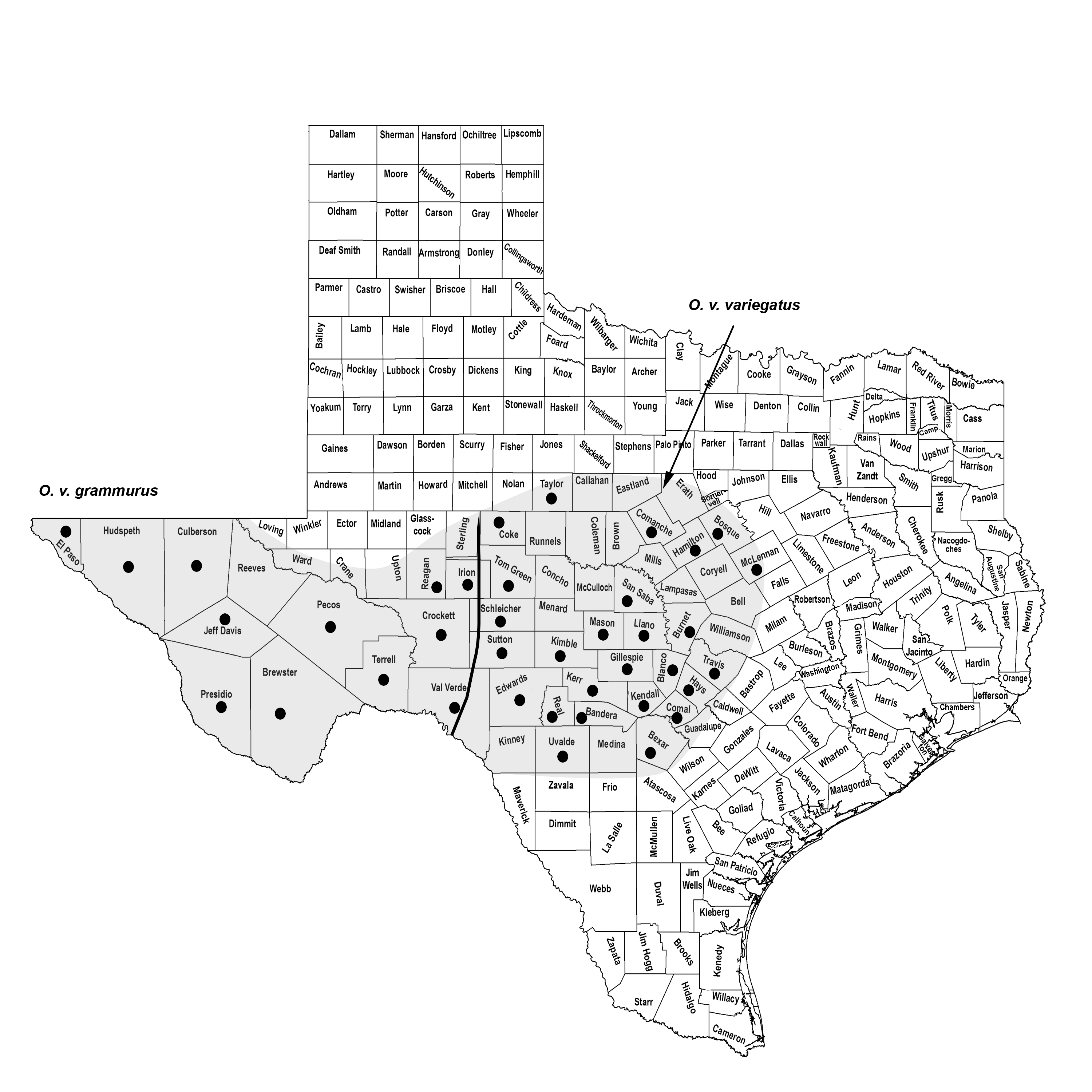ROCK SQUIRREL
Otospermophilus variegatus (Erxleben 1877)
Order Rodentia : Family Sciuridae
DESCRIPTION. A large, moderately bushy-tailed ground squirrel (previously treated as Spermophilus variegatus; see "Remarks"). Upperparts mottled grayish brown, the hind back and rump more brownish (head or head and upper back blackish in some parts of the state); tail mixed buff and brown, edged with white; underparts buffy white or pinkish buff. Dental formula: I 1/1, C 0/0, Pm 2/1, M 3/3 × 2 = 22. Averages for external measurements: total length, 468 mm; tail, 210 mm; hind foot, 57 mm. Weight of adults, 600–800 g.

DISTRIBUTION. Known from the Trans-Pecos and central regions of the state. On the Llano Estacado, it is known only from the extreme northwestern part of the plateau in Quay County, New Mexico, just west of the Texas border.

SUBSPECIES. Otospermophilus v. buckleyi in south-central Texas and O. v. grammurus to the west.
HABITS. Rock squirrels are nearly always found in rocky areas—cliffs, canyon walls, talus slopes, boulder piles, rocky fills along highways, and so forth—where they seek refuge and dig their dens. In the Pecos River Canyon in western Texas, where the walls are a series of alternating, nearly vertical precipices and narrow horizontal shelves, these squirrels are quite common. They scale the steep, smooth walls with speed and agility.
Although typical ground squirrels in most respects, rock squirrels can climb trees nearly as well as tree squirrels. In the Guadalupe Mountains of western Texas they have been observed 5 or 6 m up in the flowering stalks of agaves feeding on the flowers and buds. They also climb to the tops of junipers to forage on the berries and in mesquites to feed on the buds or beans. Occasionally they den in tree hollows 5 or 6 m from the ground. The usual den, however, is a burrow dug under rock or tree roots; others are in crevices in rock masonry along railroads and highways, cavities in piles of boulders, or small caves and crevices in rocky outcrops. They are diurnal and most active in early morning and late afternoon, but they are rather shy and difficult to observe at close range. Their call is usually a repeated, sharp, clear whistle.
They feed on a variety of plant materials, depending on availability. Known items include acorns, pine nuts, walnuts, seeds of mesquite, cactus, saltbush, agave, wild gourd, cherries, sumac, spurge, serviceberry, berries of currant and juniper, and all sorts of cultivated fruits and vegetables. Insects also contribute to their diet, especially grasshoppers, crickets, and caterpillars. They have been reported to catch and eat small wild turkeys and other birds.
Rock squirrels are facultative hibernators. In central Texas, they hibernate 2–4 months, from November to February or March. Fat is deposited, and they store food for winter use. At lower elevations in the Big Bend region of Texas they are active all year.
Populations of rock squirrels tend to be colonial and organized as maternal aggregations. Colonies consist of breeding females and a dominant male, with several subordinate males occupying peripheral areas of the colony. Home ranges average 0.4 ha for dominant males and 0.15 ha for females. The home ranges of males increase during the breeding season. Females become more territorial during periods of lactation and decrease the size of their home ranges. Many juveniles disperse from the home den in late summer or early fall, and yearlings may disperse from the maternal home range in the spring.
Males enter breeding condition after emerging from hibernation. Males are probably polygamous, and breeding territories are actively defended against intruding males. Breeding season extends for about 6 weeks in March and April in Texas. The gestation period is not known for this species. One litter is produced per year. The young are born in late spring and emerge from burrows from the end of May to mid-August. The number of young in a litter varies from one to seven with an average of four. In years of mild climatic conditions, or in warmer regions, it is possible that a second litter will be produced. Young about quarter grown have been captured as early as June and as late as 20 September.
POPULATION STATUS. Common. Rock squirrels are quite common throughout their range and seem to have adapted well to human encroachment.
CONSERVATION STATUS. The IUCN recognizes the rock squirrel as Spermophilus
variegatus and lists it as a species of least concern. It does not appear on the federal or
state lists of concerned species. No conservation efforts are needed.
REMARKS. Formerly included as Spermophilus variegatus, a 2009 taxonomic revision by Chris Helgen and colleagues (Smithsonian Institution) necessitated placement of the rock squirrel into the genus Otospermophilus.
Throughout most of their range (Utah to southern Mexico), rock squirrels are generally a grayish-brown color. However, in portions of the Edwards Plateau (especially areas surrounding Junction, Texas) these squirrels exhibit a black patch on the head that may extend onto the rump in some individuals.
From The Mammals of Texas, Seventh Edition by David J. Schmidly and Robert D. Bradley, copyright © 1994, 2004, 2016. Courtesy of the University of Texas Press.
Natural Science Research Laboratory
-
Address
Museum of Texas Tech University, 3301 4th street, Lubbock, TX 79409 -
Phone
806.742.2486 -
Email
nsrl.museum@ttu.edu

